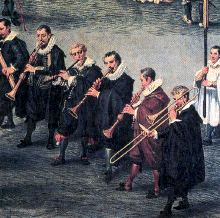|
Composers

Bach

Handel

Haydn

Mozart

Beethoven

Liszt

Brahms

Mendelssohn

Rachmaninov
|

Concerto
A musical piece designated for
a soloist or soloists and an orchestra. The
concerto consists of three movements.
The first is fast, and usually in the sonata
form .
The second movement is slow and poetic, singing-like, and the third one
is fast, again, often in the rondo-sonata .
The second movement is slow and poetic, singing-like, and the third one
is fast, again, often in the rondo-sonata or sonata-variations. At the end of the first movement there is a cadenza
or sonata-variations. At the end of the first movement there is a cadenza ,
where the soloist displays his virtuoso abilities and sometimes even improvises
(without any pre-written notes).
In the past, that is in the Baroque ,
where the soloist displays his virtuoso abilities and sometimes even improvises
(without any pre-written notes).
In the past, that is in the Baroque ,
the more common form of concerto was the concerto
grosso ,
the more common form of concerto was the concerto
grosso ,
in which a small group of instrumentalists played versus the entire orchestra
("Soli" versus "Ripieno"). Bach ,
in which a small group of instrumentalists played versus the entire orchestra
("Soli" versus "Ripieno"). Bach wrote many Concerti Grossi
wrote many Concerti Grossi ,
among which is the Brandenburg Concerti ,
among which is the Brandenburg Concerti  .
Handel .
Handel also composed 12
serious, profound Concerti Grossi.
In the classical period the concerto
becomes personal - The concerto
solo. Composers place the single soloist to play against
the orchestra. Haydn
also composed 12
serious, profound Concerti Grossi.
In the classical period the concerto
becomes personal - The concerto
solo. Composers place the single soloist to play against
the orchestra. Haydn wrote many concerti
wrote many concerti ,
among which is the excellent Trumpet Concerto,
yet Mozart ,
among which is the excellent Trumpet Concerto,
yet Mozart was the one who shaped the classic concerto
was the one who shaped the classic concerto  .
He wrote about 50 concerti for different solo instruments, and the last
ten Piano Concerti are particularly good.
Piano Concerto no. 21 .
He wrote about 50 concerti for different solo instruments, and the last
ten Piano Concerti are particularly good.
Piano Concerto no. 21   is mostly known for the slow movement used in the motion picture "Elvira
Madigan". His Clarinet
Concerto and Violin
Concerto no. 3 are also considered among the
best of his work.
The concerto suited well the Romantic
is mostly known for the slow movement used in the motion picture "Elvira
Madigan". His Clarinet
Concerto and Violin
Concerto no. 3 are also considered among the
best of his work.
The concerto suited well the Romantic period, an era that favored the individual
and his personal expression. As a person who
represented the Romantic period in both art and life, Beethoven
period, an era that favored the individual
and his personal expression. As a person who
represented the Romantic period in both art and life, Beethoven composed special, profound concerti. His Piano
Concerto no. 5 "The Emperor"
composed special, profound concerti. His Piano
Concerto no. 5 "The Emperor" and Piano Concerto no. 3
are some of the best in the history of music. They include a first movement
that is "heavier" than what was customary before. Beethoven's
Violin Concerto
and Piano Concerto no. 3
are some of the best in the history of music. They include a first movement
that is "heavier" than what was customary before. Beethoven's
Violin Concerto is also one of the summits of this genre, although it geniusly integrates
the solo violinist in the orchestra, rather than demonstrates his capability.
Mendelssohn
is also one of the summits of this genre, although it geniusly integrates
the solo violinist in the orchestra, rather than demonstrates his capability.
Mendelssohn wrote the E minor
Violin Concerto
wrote the E minor
Violin Concerto   ,
of the favourites in orchestral repertory, and Liszt ,
of the favourites in orchestral repertory, and Liszt wrote the spectacular Piano
Concerto no. 1. In his Violin
Concerto and diametrically opposed characterized
Piano Concerti,
Brahms
wrote the spectacular Piano
Concerto no. 1. In his Violin
Concerto and diametrically opposed characterized
Piano Concerti,
Brahms also represents the Romantic concerto
at its finest
also represents the Romantic concerto
at its finest . .

Examples of concerto parts
 Concerto for Piccolo in C
by Vivaldi
Concerto for Piccolo in C
by Vivaldi
|
 Allegro aperto from Flute Concerto in D (K.314)
by Mozart
Allegro aperto from Flute Concerto in D (K.314)
by Mozart
|
 Piano Concerto No.2 in Cm, Op.18 (movement 2)
by Rachmaninov
Piano Concerto No.2 in Cm, Op.18 (movement 2)
by Rachmaninov
|
|
Xtend
 Listen
Listen
 Period
Period
 Scheme
Scheme
 Notes
Notes
 Dictionary
Dictionary
 Internet
Internet
 Projects
Projects
 Finders
Finders
|
